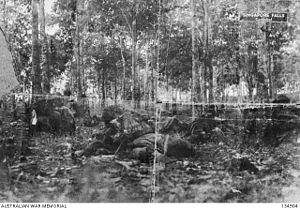 |
| Japanese soldiers in Bukit Timah |
The Battle of Bukit Timah, which took place on 11 February 1942, was part of the final stage of the Empire of Japan's invasion of Singapore during World War II. By 10 February, the Japanese had landed in full force on Singapore Island. They controlled the entire western part of the island, and much of the north. Their next objective was Bukit Timah and the capture of vital water, food, ammunition, and vehicles, machine parts and other supplies. Now, flushed with success, the Japanese again advanced in full force.
There followed some hand-to-hand combat, as well as bayonet charges from both sides. In this stage of battle, Dalforce, an irregular force made up of ethnic Chinese men from Singapore, took heavy losses. The poorly trained and equipped members of Dalforce were armed only with parangs, grenades, rifles and shotguns normally used for hunting, and suffered heavy casualties. By midnight, the Japanese had overwhelmed the defenders and captured Bukit Timah.
On that night, the Japanese 5th Division, supported by tanks, advanced down Choa Chu KangRoad. The 12th Indian Brigade and some British troops under Major Angus MacDonald and Captain Mike Blackwood (both were officers from the Argylls who would both later die on the steamship Rooseboom while escaping Singapore) blocked the road and opened fire with an anti-tank gun, destroying the first Japanese tank, but this was merely the first of a force of 50 tanks.
 |
| Japanese troops assaulting Bukit Timah hill, under Allied fire. |
The British launched a counterattack the following morning with two brigades. But by midday, faced with strong Japanese resistance, the counterattack failed.
The next day, the Japanese Imperial Guards advanced from the north, outflanking the British defenders and forcing their retreat. In the ensuing battle, the Chinese members of Dalforce fought bravely, some to their deaths. Here, the Japanese suffered some of their heaviest casualties in the campaign to occupy Singapore. In revenge, they massacred Chinese men, women and children living in a nearby village.
Source: http://en.wikipedia.org/wiki/Japanese_occupation_of_Singapore (Date accessed: 17 Feb 13)
Source: http://en.wikipedia.org/wiki/Japanese_occupation_of_Singapore (Date accessed: 17 Feb 13)
No comments:
Post a Comment